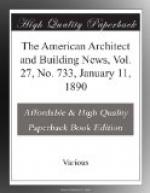Civil architecture, in the proper sense of the term, originated with the Greeks and was extended in a surprising degree among the Romans. All the other peoples of antiquity devoted themselves to the rearing of religious and sepulchral monuments, and to the construction of palaces for their sovereigns. Their political organization did not lend itself to development in other directions. So long as a people is not considered as an individual there can be no thought of erecting for its comfort or education structures of any considerable importance; so long as it has no existence as a civil body there can be no call for the building of edifices wherein to discuss its own affairs or the affairs of State. Nevertheless, aside from temples and palaces, there are certain works of public utility which are forced upon all civilizations, and among all organized peoples a domestic architecture exists which answers to their needs and which we cannot pass over in silence.
The sacred books of the Hindoos give us the plans on which their cities were built. There were forty different kinds of cities, distinguished one from the other by their extent and form. The streets crossed at right angles. The centre of the city was reserved for sacred uses and was inhabited by the Brahmins; around them dwelt the people, and the angles were occupied by the exchanges, markets, colleges and other public structures. The city was always walled, with a gate on each of the four sides and one at each corner.
Private dwellings varied in height according to the rank of the owners. Those of the inferior classes could have only one story above the ground-floor, and in most cases they were limited to the ground-floor itself. The door was never placed in the centre of the facade. Its position, as well as its height and breadth, was fixed by rule; the same was true of the windows. The streets were supplied with running water, and adorned with avenues of trees; they were bordered by rich shops and houses set close together, with no intervening spaces. The palaces, which were composed of separate buildings, approached by porches, were usually erected around small courts, and these courts were almost always planted with trees. The roofs were flat, and the narrow, rude staircases were made in the thickness of the walls. The Hindoos also constructed huge reservoirs, and reared columns and square triumphal arches in honor of their heroic victors; they are also known to have built bridges, the piles of which, formed of enormous blocks, were connected by stones of a single piece.
Passing into China we encounter a civilization whose antiquity rivals that of India. However, there are no very ancient remains there. But there is documentary evidence that the Chinese, several centuries before the Christian era, built from the same designs that they use to-day. Architecture being the expression of the needs, instincts, character and traditions of a people, and the Chinese having in no way modified their manner of living or their traditions, we can easily understand why their architecture has undergone no modifications.




